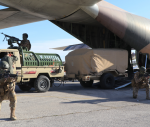You are here
Syria’s legacy of famine
Jan 13,2016 - Last updated at Jan 13,2016
Like everything else in the bloody five-year-old Syrian conflict, the international community was late to step in to end the horrific suffering of the residents of Madaya, a small town northwest of Damascus, which has been under crippling siege for more than six months.
Only recently did shocking images and video footage of starving children and elderly became public, filling TV screens and social media platforms.
The plight of Madaya’s 40,000 inhabitants, mostly displaced families who had fled neighbouring towns, overshadowed the daily suffering of Syrians in other beleaguered towns and cities.
The outrageous images underline the fact that the Syrian conflict had breached every humanitarian law, treaty and convention in existence, and that despite the latest outcry, atrocities against civilians and non-combatants continue unabated.
Madaya’s Sunni population has been under siege by government and Hizbollah fighters. Eyewitness testimonies from activists and residents confirm that Madaya has been denied aid in a bid to subjugate the population.
Those who attempted to flee faced landmines and sniper fire.
Tens of people died of hunger while hundreds suffer from disease, cold and starvation.
It is a vicious form of collective punishment by a government that has killed, gassed, tortured and besieged its own people. More than this, the punishment has been meted against civilians who were not involved in military activities.
The plight of Madaya is not unique to Syria. Tens of villages, towns, neighbourhoods and refugee camps are under siege, either by government forces or the insurgents.
The scope of the humanitarian crisis in Syria is appalling and disgraceful.
Despite recent efforts to launch a political solution to end the Syrian conflict, little has been done to alleviate civilian suffering.
The situation is dire in rebel-controlled Damascus’ western and southern countryside. But while opposition militias have also laid siege to Shiite towns like Kefraya and Fou’a, humanitarian aid continued to flow into these areas. So far there are no confirmed reports
that residents in these villages are facing starvation.
The case of Madaya underlines a tactic used by the regime and its Hizbollah and Iranian Revolutionary Guard allies. Starvation has become an approved policy that aims at strengthening the bargaining position of the regime as it negotiates an interim truce with the opposition.
This policy has been followed in Yarmouk Refugee Camp, near Damascus, in Homs, Hamah and recently in Zabadani.
But there is a more sinister goal by the regime and its allies, which is the transfer of Sunni residents from their towns and villages as far away as possible from Damascus and its countryside.
The sectarian element in this confrontation cannot be discounted. When the use of chemical gas, barrel bombs and indiscriminate shelling failed to dislodge rebel fighters, the regime resorted to long-term siege of civilian areas.
In all these cases, the international community has failed to incriminate the regime for committing war crimes and crimes against humanity.
Sadly, atrocities against civilians will increase in the coming weeks as the regime seeks to improve its gains on the ground ahead of the Geneva negotiations.
And ironically, the political roadmap proposed by the UN Security Council and previous declarations in Vienna fail to set parameters to end civilian suffering and improve the humanitarian situation.
Furthermore, there are no signs that the terrible crimes that the regime, as well as some militias, had carried out will be judged in the near future.
More than 300,000 are dead, hundreds of thousands are missing in regime prisons and millions are displaced, yet the humanitarian aspect of the Syrian crisis has never been addressed satisfactorily by the international community and regional interlocutors.
With the US-led air campaign in Syria and Russia’s direct intervention there, it is shameful that the plight of besieged Syrian towns and villages has never received the proper attention from Washington and Moscow.
The planes that drop bombs on hostile targets could also deliver much-needed humanitarian aid to starving civilians.
The double standards applied by all parties involved in the Syrian conflict are inexcusable.
By the same token, one should not excuse Arab and regional countries that have a stake in the future of Syria. These countries, which are able to supply weapons and ammunition to various opposition groups, could also facilitate the delivery of aid to starving Syrians.
By Monday, aid convoys managed to reach Madaya, Fou’a and Kefraya. The conditions in other besieged towns and villages in Der El Zour, Mua’dmayat Al Sham and Duma, among others, remain dire.
The political process cannot begin if civilians continue to suffer and hundreds of Syrians are dying because of lack of food, water and medical care.
Negotiations between the regime and the opposition will take a long time and are not guaranteed to succeed.
UN-brokered talks should be preceded by an immediate ceasefire and an end to collective punishment. The horrific images of starving Syrian children represent the bitter legacy of this terrible conflict.
The writer is a journalist and political commentator based in Amman.













